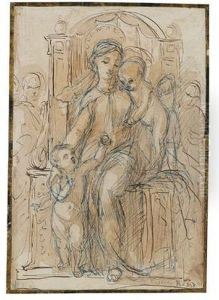Pio Fedi Paintings
Pio Fedi was an Italian sculptor of the 19th century, whose work is characterized by its detailed execution and historical themes. Born in Florence, Italy, in 1816, Fedi was part of the vibrant artistic milieu that defined the Tuscan capital during his lifetime. He studied at the prestigious Academy of Fine Arts in Florence, where he was deeply influenced by the Renaissance masters, as well as by his contemporaries in the burgeoning Romantic movement. His education and talent set the stage for a career that would leave a lasting mark on Italian sculpture.
Fedi is perhaps best known for his masterpiece, the 'Rape of Polyxena', a stunning marble sculpture that resides in the Loggia dei Lanzi in Florence. Completed in 1865, this work exemplifies Fedi's skill in capturing dynamic movement and emotion, as well as his ability to convey complex narratives through sculpture. The 'Rape of Polyxena' is often admired for its intricate detail and the lifelike quality of its figures, showcasing Fedi's mastery over his medium.
Throughout his career, Fedi received numerous commissions, many of which reflected the political and cultural currents of his time. His works can be found in various public and private collections, highlighting his reputation as one of the era's leading sculptors. Despite the acclaim he received during his lifetime, Pio Fedi's contributions to art have not always been widely recognized outside of Italy, overshadowed perhaps by some of his contemporaries.
Fedi's style, while rooted in the classical traditions, also reflected the transition to more modern sensibilities, bridging the gap between the neoclassical and the emerging modernist movements. His ability to imbue traditional subjects with a sense of immediacy and emotional depth resonates with viewers even today.
Pio Fedi died in 1892 in Florence, leaving behind a legacy of artistic achievement that continues to be celebrated for its technical excellence and its emotional impact. His work remains a testament to the rich artistic heritage of Italy and to the enduring power of sculpture to convey complex human experiences.


